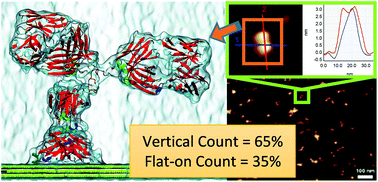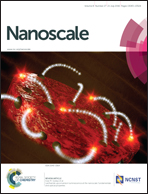Adsorption orientations and immunological recognition of antibodies on graphene†
Abstract
Large-scale molecular dynamics (MD) simulations and atomic force microscopy (AFM) in liquid are combined to characterize the adsorption of Immunoglobulin G (IgG) antibodies over a hydrophobic surface modeled with a three-layer graphene slab. We consider explicitly the water solvent, simulating systems with massive sizes (up to 770 000 atoms), for four different adsorption orientations. Protocols based on steered MD to speed up the protein diffusion stage and to enhance the dehydration process are combined with long simulation times (>150 ns) in order to make sure that the final adsorption states correspond to actual stable configurations. Our MD results and the AFM images demonstrate that the IgG antibodies are strongly adsorbed, do not unfold, and retain their secondary and tertiary structures upon deposition. Statistical analysis of the AFM images shows that many of the antibodies adopt vertical orientations, even at very small coverages, which expose at least one Fab binding site for recognition events. Single molecule force spectroscopy experiments demonstrate the immunological response of the deposited antibodies by recognizing its specific antigens. The above properties together with the strong anchoring and preservation of the secondary structure, make graphene an excellent candidate for the development of immunosensors.


 Please wait while we load your content...
Please wait while we load your content...